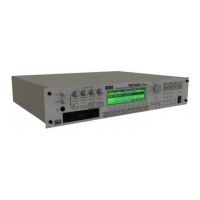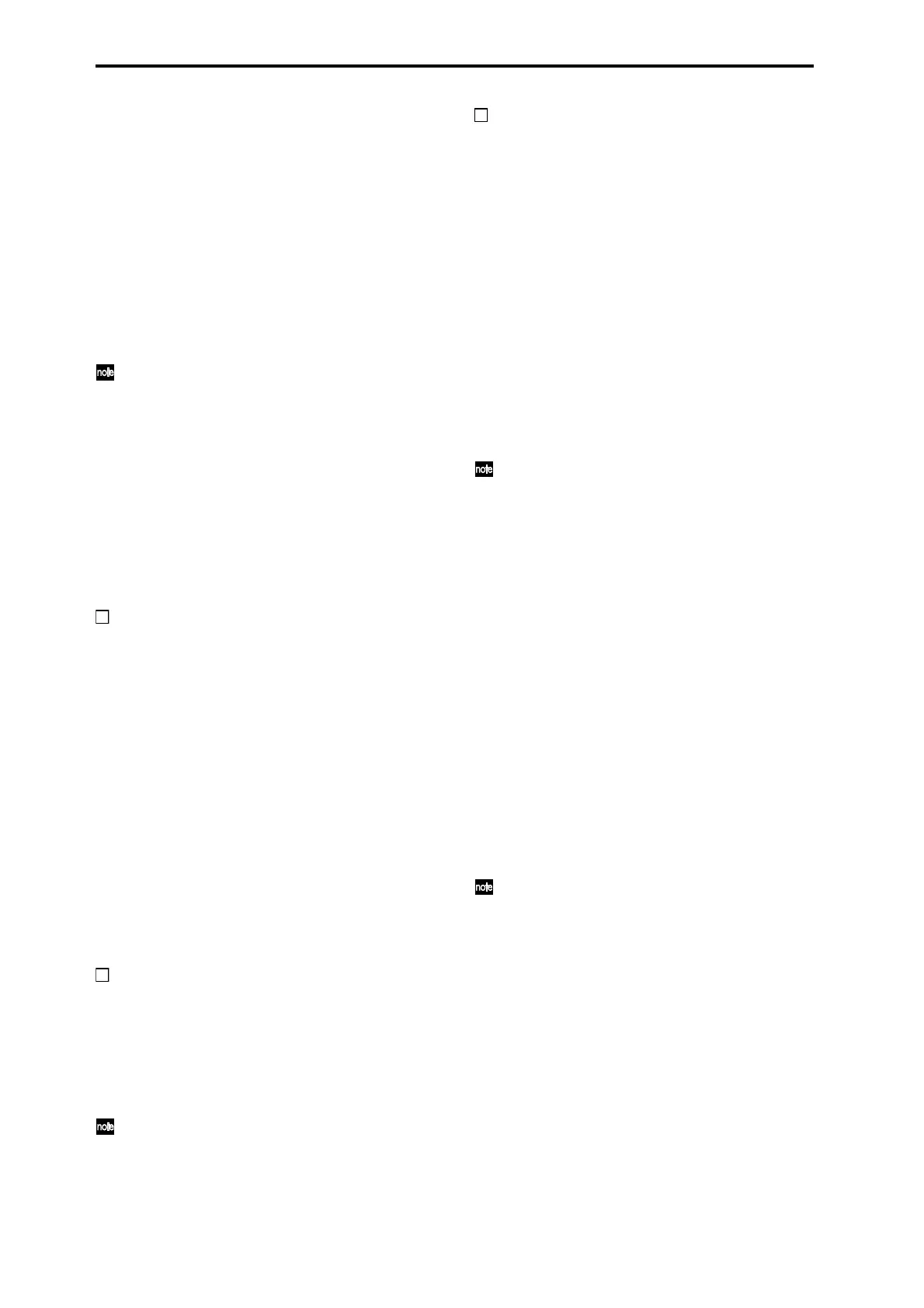222
Selecting combinations
You can use program change and bank select messages to
select combinations in the same way that you select pro-
grams.
• Combinations 000–127 in banks I-A–I-F, E-A–E-H
correspond to program changes [Cn, 00]–[Cn, 7F].
• Similarly as for program banks, the internal banks that
correspond to each bank select number will depend on
the “Bank Map” setting (GLOBAL 1.1–2a). (☞p.109
“Bank Map”)
• In COMBI 1.1: Play, program change and bank select
messages are transmitted/received on the global MIDI
channel. They are not received in 2.1: Ed–Prog/Mix –
7.3: Ed–MasterFX.
All program changes can be turned off in GLOBAL 2.1:
MIDI “MIDI Filter.”
As needed, you can independently turn all program changes
on/off, specify whether or not incoming messages will be
able to change combinations, and turn reception/transmis-
sion of bank select messages on/off.
• If “Combi” is unchecked, the combination will not
change even if a program change on the global MIDI
channel is received in COMBI 1.1: Play. In this case, the
program of the timbre that matches the MIDI channel of
the received message will change.
• If “Bank” is unchecked, bank select messages will not be
transmitted or received (☞p.112 “MIDI Filter”).
After touch
Channel after touch [Dn, vv]
(n: channel, vv: value)
When this message is received, the aftertouch effect will be
applied. The specified alternate modulation or dynamic
modulation effect will also be applied.
• After touch for the entire instrument can be turned off
in GLOBAL 2.1: MIDI “MIDI Filter.”
• In Combination and Multi modes, after touch can be
switched on/off independently for each timbre/track
(☞p.41, 58 “After Touch”).
Polyphonic key pressure [An, kk, vv]
(n: channel, kk: note number, vv: value)
There is another type of after touch called Polyphonic Key
Pressure, which allows after touch to be applied indepen-
dently for individual keys. This message can be used an
alternate modulation source. It can also be used as event
data within a pattern in Multi mode. The after touch men-
tioned in this manual refers to Channel After Touch.
Pitch bender
Pitch bender change [En, bb, mm]
(n: channel, bb: lower byte of the value, mm: upper byte of
the value, together expressing a value of 16,384 steps where
8,192 [bb, mm = 00H, 40H] is the center value)
When this message is received, a pitch bend effect will be
applied. The specified alternate modulation or dynamic
modulation effect will also be applied.
The range of pitch change that is produced by pitch
bend messages can also be adjusted via MIDI. (☞p.225
“Changing the pitch bend range”)
Control change
[Bn, cc, vv]
Transmitted and received as (n: channel, cc: control change
no., vv: value)
Refer to “MIDI transmission when the TRITON-Rack’s con-
trollers are operated” (☞p.216) and “TRITON-Rack opera-
tions when control changes are transmitted/received”
(☞p.218).
• Control changes can be turned on/off as a whole in
GLOBAL 2.1: MIDI “MIDI Filter.”
• In Combination and Multi mode, you can turn
transmission and reception on/off for each timbre/track
by making settings in the 4.1: (Ed-) MIDI Filter 1, –2–4.4:
(Ed-) MIDI Filter 4, –2 pages. For the assignable
controllers (“SW1,” “SW2,” REALTIME CONTROLS [1]–
[4] knobs), MIDI filter settings will apply to the control
change number to which each controller is assigned.
“Other Control Change” applies to control changes that
are not covered by the items of the other check boxes
(☞p.41, 58 “MIDI Filter”).
MIDI CC#00–CC#95 can be selected for the B-mode of
REALTIME CONTROLS [1]–[4] knobs.
Selecting program/combination banks
Bank select (CC#00, CC#32)
☞p.221 “Program Change/Bank Select”
Using the joystick of a connected TRITON or other
MIDI device to apply modulation
Modulation 1 depth (CC#01) [Bn, 01, vv]
When this message is received, a vibrato effect (pitch LFO)
will normally be applied. The specified alternate modula-
tion or dynamic modulation effect will also be applied.
• In Combination and Multi modes, transmission/
reception can be switched on/off for each timbre/track.
(☞p.41, 59 “JS+Y CC#01”)
Modulation 2 depth (CC#02) [Bn, 02, vv]
When this message is received, a wah effect (filter LFO) will
normally be applied. The specified alternate modulation or
dynamic modulation effect will also be applied.
• In Combination and Multi modes, transmission/
reception can be switched on/off for each timbre/track.
(☞p.41, 59 “JS–Y CC#02”)
Other manufacturers use this message for other pur-
poses (e.g., breath controller, etc.)
Controlling the portamento effect
Portamento time (CC#05) [Bn, 05, vv]
When the above CC# is assigned as a B-mode function for
one of the REALTIME CONTROLS [1]–[4] knobs, rotating
that knob will transmit Portamento Time messages, and will
modify the speed at which the portamento pitch changes.
When this message is received, the result will be the same as
when the controller is operated.
Portamento switch (CC#65) [Bn, 41, vv]
When the above CC# is assigned to “SW1,” “SW2,” operat-
ing that switch will transmit vv=127 [7F] for ON or vv=0
[00] for OFF, and the portamento effect will be switched on/
off. The specified alternate modulation or dynamic modula-
tion effect will also be applied. When this message is
received, the result will be the same as when the controller is
operated. (vv of 63 [3F] or less will be OFF, and 64 [40] or
greater will be ON.) (☞p.213 “SW1, SW2 Assign List”)

